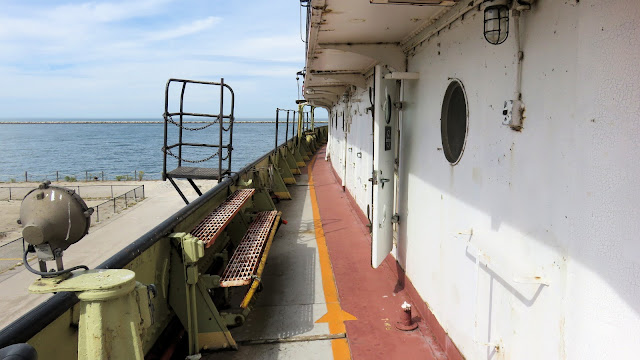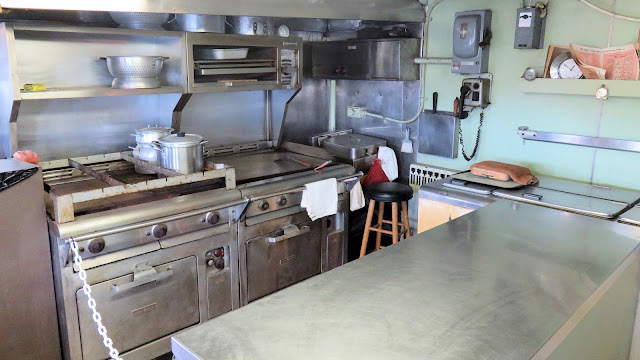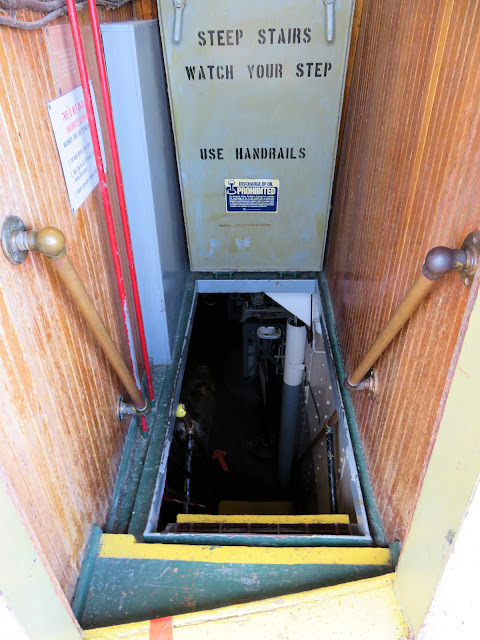-- The Bear (routinely between July 2019 and October 2021)
"We Built This City"
 |
| Steamship William G Mather, photographed 20 July 2019. |
Launched in May of 1925, the steamship William G Mather was once flagship for the Cleveland-Cliffs Iron Company. Measuring 618 feet long, the massive laker hauled so much iron ore to Cleveland steel mills that it was nicknamed the "Ship that Built Cleveland". She remained in service until 1980, experiencing multiple upgrades over the years. In 1946, she became one of the first Great Lakes haulers to be equipped with radar. Her original 2,300 horsepower, four-cylinder coal-fired reciprocating steam engine was replaced in 1954 with an oil-fired steam turbine engine that developed 5,000 horsepower. In 1964, the Mather was outfitted with a bow thruster and a computerized boiler control system, the latter being the first of its kind to be installed on a Great Lakes vessel. Because of her early implementation of these advances, the Mather is an American Society of Mechanical Engineers National Historic Mechanical Engineering Landmark. It seems fitting that such a big boat would carry such a wordy designation.
 |
| William G Mather, photographed on 20 July 2019. |
Ahab of the Sky
Today, the William G Mather is a museum ship moored along the Cleveland waterfront and open for self-guided tours. Our first attempt to visit was in September of 2018, but a fire the previous day unexpectedly closed it to tours. The following year, we returned to Cleveland and reached the gangway only to discover that the ship was closed again due to a heat advisory. "That boat hates you," The Bear asserted counterproductively as we stood at the foot of the closed gangway. Twice denied, I became even more determined to explore this grand old lady of the Great Lakes.
 |
| Tom with the William G Mather, photographed 15 September 2018. |
However, when it became clear that weather would force a cancellation of the Williamson Flying Club's annual (attempted) fall lunch in Lake Placid, Tom suggested a return to Cleveland as an alternative. Contrary to the declaration made at the beginning of the season, the Mather was indeed available for tour and we redirected our mountain fall foliage flight to the waterfront of Cleveland, OH. Expecting to lose most of the members keen to visit the colorful autumn peaks encircling Lake Placid, we were surprised to have a group of thirteen pilots and passengers hang in there for the revised destination.
 |
| William G Mather, photographed 15 September 2018. |
"If you can't go to Lake Placid, where are you going to go?" queried The Bear the night before we departed.
"We're going to see the white whale," I responded cryptically.
"The white whale?" asked The Bear, perplexed.
"Is that not a literary reference you know yet?"
"Well, sure, but I don't..." The Bear's eyes suddenly widened and her voice rose in volume with newfound certainty. "YOU'RE GOING TO SEE THE SHIP!!!"
She is a clever Bear.
Convoy
| Date | Aircraft | Route of Flight | Time (hrs) | Total (hrs) |
| 02 Oct 2021 | N21481 | SDC (Sodus, NY) - BKL (Cleveland, OH) - SDC | 4.4 | 2373.1 |
We had an early start. My previous flight in the Warrior was a two hour instrument practice session involving flying various approaches at Rochester, so I took on additional fuel before we launched to ensure a return without needing to refuel at Burke Lakefront. Somehow, paying $7/gallon to Signature for the same blue fuel available at home for much less seemed counterproductive.
 |
| WFC at Venango Regional: Lesly, Dan, Steve, Janice, me, and Scott. Photo courtesy of Dan, 06 June 2021. |
Flying with me were new member Steve and his fiancé Janice, whom I previously met at a Williamson Flying Club dinner fly-out to Primo Barone's at the Venango Regional Airport (KFKL) earlier in the year. This would be our first time flying together in the same airplane, though.
While Tom and Alicia fueled Two Six Romeo, Dan and Scott prepared One Delta Tango for flight. Paula and Steve were also part of the convoy in Nine Four Romeo. Member Gilead and his friends joined us en route with a Rochester-based Cirrus SR-22.
"Hey, Two Six Romeo," Air Traffic Control called out to Tom, "What's going on in Cleveland today?" Gaggles, even well spaced gaggles, tend to get ATC attention.
 |
| Scott flying One Delta Tango on short final for 24L. Photo by Dan. |
While Tom and Scott were cleared to land on 24 Left, we touched down on the longer 24 Right. I suppose that Lakefront Tower was trying to balance runway use.
 |
| Our arrival in Cleveland. Photo by Alicia. |
 |
| Janice and Steve with Warrior 481 on the ramp at Burke Lakefront. Tom's Two Six Romeo is parked beside us. |
Three of us parked on the free, public ramp at the base of the tower. Scott and Paula parked at Signature with the intention of taking on fuel for the return flight.
Once we had everyone gathered together, we walked a couple of blocks into downtown Cleveland to the Galleria where we had lunch at the Winking Lizard Tavern. Food options were varied, well-prepared, and delivered in substantial portions. Those who were not pilots in command enjoyed whatever was on tap. Best of all, there was no waiting for a party of thirteen people. It all worked out very well.
Compulsively Humming Gordon Lightfoot
 |
| William G Mather photographed 15 September 2018 |
One of Gilead's friends was a former mariner and pointed out how the steel plating of the Mather's hull was pressed inward between structural ribs. "That's what the waves of the sea will do," he commented. Sea nothing, I thought. The Mather had been a laker its entire life. That pounding came from the Great Lakes, not the ocean.
We explored a small portion of the forward hold that included an exhibit about the disaterous 1975 loss of the Edmund Fitzgerald on Lake Superior. I had started humming the Lightfoot ballad well before boarding the laker, but reading specifics about the Edmund Fitz only served to set the earworm deeper.
Bow Superstructure
As a flagship freighter, the Mather was a curious blend of elegance and utilitarianism. By way of example, the lower guest lounge was well-appointed with hardwoods and a fireplace.
Stairs led to the large upper guest lounge that looked forward over the bow of the ship.
Accommodations varied in comfort. Pictured above and below were typical crew quarters.
Guest quarters were nicer than accommodations meant for deckhands. Guests on the Mather would have included industry executives, politicians, and families and friends of Cleveland Cliffs executives and ship officers. Sometimes, William G Mather himself -- the president of Cleveland Cliffs -- voyaged on the Mather.
The upper guest lounge was significantly more spacious than the lower and offered a view directly forward of the ship. It was positioned immediately below the ship's pilothouse.
Surely, this TV was not still in service when the Mather retired in 1980!
Because the main kitchen was located at the stern of the ship, a small kitchenette was available off the upper guest lobby.
The main deck featured multiple telescoping hatches over access points to the four cargo holds. The primary mission of the Mather was to haul iron ore from Duluth, MN to Cleveland, OH. Sailing from Cleveland to the Upper Great Lakes, she was usually laden with coal, salt, or grain to subsidize return trips to the iron mines. The Mather could carry nearly 14,000 tons of iron ore.
 |
| Tom and Alicia pose at the bow of the ship. |
Truly, their hearts will go on.
Consistent with the way accommodations varied with station, the captain enjoyed a well-appointed three room suite near the bow that consisted of an office area (above) and a private bedroom (below) with an adjoining private head. Fittingly, a set of stairs led directly upward to the bridge.
This photo is a Ghostbusters joke just waiting to happen.
Valuables were safely stored in the captain's Detroit-built safe.
Which Station is Mr. Sulu's?
While it is no USS Enterprise, the bridge of the Mather was elegantly appointed in oak and brass. After all, it was constructed to serve as the flagship for Cleveland Cliffs.
This is the engine order telegraph (EOT). A matching unit stands before the engine control console in the Mather's engine room, ready to receive instructions based on the EOT setting in the pilothouse.
As far as I can discern, this device was essentially a nautical ADF (automatic direction finder), an early form of radio navigation that I needed to understand to earn my instrument rating. However, I have never actually used an ADF. The closest I came was tearing my arm open on the former ADF antenna mount that remained on top of Warrior 481's cabin years after all the ADF equipment was actually removed. That mount is gone now too, but I still have a scar on my arm.
This is one of two radar displays on the bridge. Peering into the viewfinder, I had a moment of existential crisis when I saw my own eyes looking back at me.
 |
| View of the Rock & Roll Hall of Fame and Cleveland from the Mather. |
The Promenade Deck
The only way to reach the island superstructure on the aft portion of the ship is to walk the long deck over the cargo holds.
This seemed like good advice. Falling through one of these hatches into an empty hold is not a tumble that I would care to take.
At this angle, the telescoping nature of the hatches is evident.
Burke Lakefront Airport was readily visible from the deck of the Mather.
Zooming in, I could see Warrior 481 and Tom's Two Six Romeo. I suspected that my parking job was a bit crooked; this confirms it.
These windows provided natural light for the four story deep engine room.
As a throwback to the sailing ships of old, the aft deck featured an auxiliary ship's wheel.
An extra propeller blade was available on the aft deck, though it seemed somewhat the worst for wear.
Mess Deck
 |
| Mmmm...sausage making.... |
The guest's dining room was the most elegantly appointed on the Mather.
Next door, the officer's mess was more spartan, but a step up from where most ship's hands ate. I confess to some idle curiosity about "Canadian Cheese Soup" and desperately hope that it is not simply the vat of molten Velveeta that I initially envisioned.
The large kitchen was built to accommodate a crew of 38 plus guests.
Give Me Steam!
The engine room is four stories high, built to accommodate the original 1925 engine. Steep stairways descend into the abyss, eerily lit by flickering lights below.
This equipment is for the Mather's power steering system, translating commands from the ship's wheel into the force required to move the laker's massive rudder.
The ability to make en route repairs is a must!
This is the main part of the engine room showing the 5,000 horsepower steam turbine that replaced the original engine in 1954.
This computer is the brain of the 1964 Bailey 760 automated boiler control system.
This is the engine room's corresponding engine order telegraph. Any time the setting was changed on the bridge, this indicator would mirror the new setting and ring a bell to alert the engineers that a change needed to be made.
This port gave a direct view into the single oil-fired boiler. This replaced the original three coal-fired boilers that the Mather launched with in 1925. Clearly, the engine room was once a much more crowded space than it is today.
According to various sources, this diesel engine would have allowed the Mather to limp to a port in the event that the primary engine failed.
The tour ends at this aft hatch adjacent to the engine room.
In the end, it was worth the wait. It is always fun to land at Burke Lakefront, especially with a group. Lunch was delicious. And the William G Mather is a well-preserved example of Great Lakes shipping that embodies many engineering advances that occurred throughout the twentieth century. While I appreciated the self-paced nature of the tour and learned a lot from it, I sometimes wished that a knowledgeable docent had been available -- particularly in the engine room -- to help explain some of the things I was seeing. The Mather certainly made our Pipers feel awfully puny in comparison.
Return To Sodus
 |
| Two Six Romeo departing Burke Lakefront with the Mather at frame center. Photo by Alicia. |
We returned to Burke Lakefront Airport, paid our $7 landing fee (the airport authority no longer invoices by mail), and departed for home. It was a quiet ride. Steve and I talked about flying. Janice snoozed in the back seat. In all, it was another fun and successful trip with the Williamson Flying Club.








































































No comments:
Post a Comment